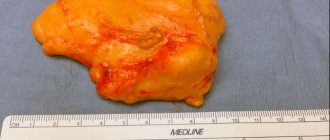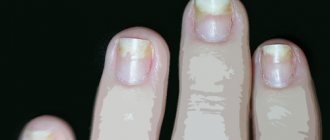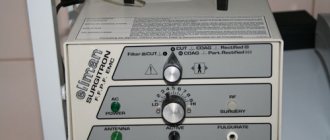Home > Laser surgery / Removal of tumors / Removal of lipomas > Laser removal of wen on the neck
Wen on the neck can cause a lot of inconvenience and should be removed. Not necessarily surgically: laser technologies are also suitable.
A lump on the neck, near the ear or throat, can not only spoil the appearance, but also cause a lot of inconvenience. If the location is unsuccessful, the lipoma can interfere with breathing. The risk of injury is also high due to the collar.
Consultation on the day of the procedure is free
Lipoma. What is this?
Lipoma
– benign neoplasm from adipose tissue (tumor, lump, nodule, lump, ball under the skin). It is usually round or oval. The skin above it does not differ in color from the surrounding skin. The tumor is soft, elastic, and painless to the touch. Most often there is a single one, there may be several or many of them (lipomatosis). In everyday life it is often called a wen, a lump or a knot under the skin. The causes may be heredity, lipid metabolism disorder, hormonal imbalance, injury and others.
Most often, such formations appear on the torso, on the lower and upper extremities, in the area of the shoulder blades and on the neck. Their size can be from 0.5 cm or more. Giant tumors occur.
As a rule, small formations do not hurt, do not pose any particular danger and are not even detected visually, but only by palpation (feeling). While large ones are clearly visible, they bring aesthetic problems and can cause pain due to compression of surrounding tissues. Benign tumors of this type are not characterized by rapid growth and inflammation.
Lipoma must be distinguished (differentiated) from other lumps and formations under the skin (atheroma, fibroma, hydroadenitis, lymphadenitis, lymphoma, cancer metastasis, hernia and others). This requires consultation with a surgeon, since their treatment tactics are different.
To clarify the diagnosis, ultrasound diagnostics and tomography may be required.
After the operation, a histological examination of the removed material is required, which helps to definitively establish the type and nature of the tumor (benign or malignant).
What to do if it festers and bursts on its own?
So, if the capsule of the wen accidentally ruptures, a specific substance, similar in consistency to a thick cream, immediately flows out of it. Minor bleeding is also possible due to damage to the capillaries in the skin. When faced with such symptoms, you must:
- Use a napkin and carefully remove the discharge.
- Wipe the skin with any non-aggressive antiseptic. An excellent find could be inexpensive Chlorhexidine or the familiar hydrogen peroxide. Alcohol and iodine should not be used, as this can cause a burn, and the coloring components of iodine will subsequently prevent the doctor from adequately assessing the condition of the wound.
- Afterwards, you can apply Levomekol ointment to the skin, cover it with a cotton sponge or a medical napkin and secure this structure with a band-aid. This simple recommendation will help avoid the spread of the inflammatory process and prevent pathogenic microorganisms from entering the wound.
- In the absence of Levomekol, the use of a regular sterile gauze bandage is allowed.
Lipomatosis
When there are many lipomas (up to 100 or more), the disease is called lipomatosis.
Varieties:
- multiple, familial or Rocha-Lori
- multiple symmetrical or Madelunga
- painful or Dercuma
Contraindications for surgery
Surgical removal of a lipoma, like any other surgical intervention, has a wide range of contraindications.
- Thus, surgical removal of wen is not performed on women in an “interesting” position, or during breastfeeding. Doctors recommend refusing surgery during “critical days.”
- Herpes, recent colds or infectious diseases are also reasons to undergo surgery.
- It is highly undesirable to perform surgical removal of a wen if the patient has been diagnosed with diabetes.
- Surgical removal is also fraught with complications due to secondary immunodeficiency - in other words, reduced body resistance.
Lipoma treatment. Surgical removal of the wen
The lipoma is removed surgically. The operation should be painless. It is performed on an outpatient basis under local anesthesia or on an inpatient basis for larger cases under general anesthesia. Before surgery, the surgical field is treated with modern antiseptics (Kutasept and others). With local anesthesia, injections are made with an anesthetic (anesthetic - novocaine, lidocaine and others).
Then, with a scalpel, an incision is made above the lump in accordance with its size. Through this access, the overgrown adipose tissue along with its capsule (shell) is extracted (excised, excised).
The postoperative wound is washed (sanitized) with antiseptics. Sutures are applied (regular interrupted, Donati or cosmetic).
The sutured wound is covered with a sterile self-adhesive aseptic breathable bandage made of soft non-woven material with an absorbent pad (viscose). The dressing is selected according to the size of the wound defect. The absorbent layer must completely cover the wound to fully absorb the discharge. Lipoma can also be removed using laser and liposuction.
How a doctor can help you remove a wen
It is highly advisable that lipoma removal be performed by an experienced specialist. After a thorough examination, a dermatologist may prescribe the following procedures to remove wen:
- Mechanical cleaning. This method is considered the simplest. The procedure is carried out by piercing the wen with a needle, after which all its contents are removed. Sometimes the procedure is performed under local anesthesia.
- Removal of lipoma with laser . Laser therapy is considered the most progressive method for removing fatty tissue. The procedure is very quick and does not leave scars. In addition, the possibility of the wen reappearing in the same place is excluded.
Prevention
To exclude the possibility of the appearance of benign fatty tumors, at a minimum, maintaining a healthy lifestyle is required. It is necessary to exclude bad habits and factors that can provoke changes in adipose tissue (stress, increased blood sugar). During hormone therapy or if you suspect a hormonal imbalance, you need to monitor your hormonal levels under the supervision of an endocrinologist. It is very important to periodically carefully examine and palpate the skin to prevent the appearance of neoplasms. To do this, you can involve relatives and close people. If you identify nodes, compactions, infiltrates, lumps or other formations, consult a surgeon. Don't delay.
Reasons for appearance
There are many factors that influence the formation of lipomas. Among the reasons are hereditary predisposition, impaired metabolism of fatty acids in the body, liver disease, pancreatic disease, non-compliance or violation of hygiene rules.
For a long time it was believed that soft tissue injury predisposes to the development of lipomas, but this fact was subsequently refuted in research. Thus, doctors agree that one reason that would explain all the processes has not yet been found. However, predisposition to gastrointestinal lipomas has a proven connection with a gene mutation on chromosome 12. In other cases, the reasons remain unknown.
Reviews:
Alexander
I have hereditary lipomatosis. My father also has the same problem. About 5 years ago, lipomas appeared and began to increase in size on the arms, legs and abdomen. At first I tried not to pay attention to them, but others notice them. He began to hide them. I had to wear only long sleeves and only trousers, even in the summer, and this is really annoying. But most importantly, new formations appeared. They hurt when pressed. On my back they even began to interfere with my sleep. Sheer discomfort. I turned to Alexander Shadzhievich, he explained everything and at the same time removed 11 wen in one visit using the radio wave method. I liked that there was no pain during removal, only minor discomfort at the beginning of anesthesia. The syringe and needle were small. The operation went almost unnoticed. After the operation there was no pain either. I did the dressing myself. Very simple. The doctor recommended comfortable small bandages that do not come off. I was very afraid that the scars after the operation would be large, but I managed to remove lipomas from small incisions. Small scars remain. The entire operation took about 1.5 hours. Previously, I applied to other places, but they offered to remove 2-3 formations at a time and the price was higher. The clinic at the place of residence refused to remove it at all. It is very convenient that many formations were removed at once, most of them. The main thing is that the largest ones were removed. It became easier. There are a few very small, unnoticeable lipomas left; if they grow, I’ll remove them later too. Thank you doctor for your attentive attitude, I am very pleased.
Valery
Maksim
Anton
Maksim
Can it burst on its own?
Wen is not dangerous to life and health.
The tumor never becomes malignant; it is enclosed in a capsule. But under certain circumstances, inflammation and even a breakthrough to the surface of the skin is possible. Provoking factors of inflammation:
- regular mechanical impact with a comb, hairpins, jewelry;
- injury from a fall or fight;
- rubbing with tight underwear, shoes;
- attempts to squeeze out or cut off a lipoma at home, it may burst.
Suppuration causes aching pain, aggravated by palpation, hyperemia, and increased formation. Soon spontaneous opening occurs, which is dangerous due to secondary infection. If the wen bursts under the skin, you need to contact a surgeon to develop treatment tactics.
How are atheromas and lipomas treated?
Atheromas are treated surgically; the type of operation will depend on the size of the formation. Small sebaceous cysts can be removed with a laser. Most often, atheromas are large in size and are removed with a scalpel. The “bump” on the skin is surrounded by two incisions, then the cyst is peeled out and removed along with a small piece of skin. Stitches are placed on the wound.
Atheroma cannot be cured by “sucking out” the contents with a needle and syringe. It is imperative to remove the walls of the stretched sebaceous gland - if they remain, they will begin to produce sebum again, and the cyst will grow again.
If atheroma suppurates, surgical treatment is performed, and the doctor may prescribe a course of antibiotics. Lipomas do not need to be treated. The operation is performed if:
- education is large and growing rapidly;
- the lipoma is in an inconvenient place and is constantly in the way;
- bothered by soreness;
- The patient himself insists on removing the lipoma.
Wen is removed in the classic way, using a scalpel. Relapses are possible, but extremely rare. Typically, atheromas and lipomas are removed on an outpatient basis; hospitalization is not necessary. Anesthesia is also not needed - local anesthesia is sufficient. The operation lasts on average 15–20 minutes.
Make an appointment by phone +7 (495) 120-08-07.










